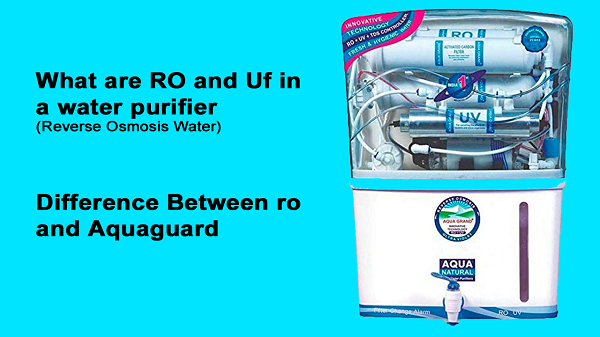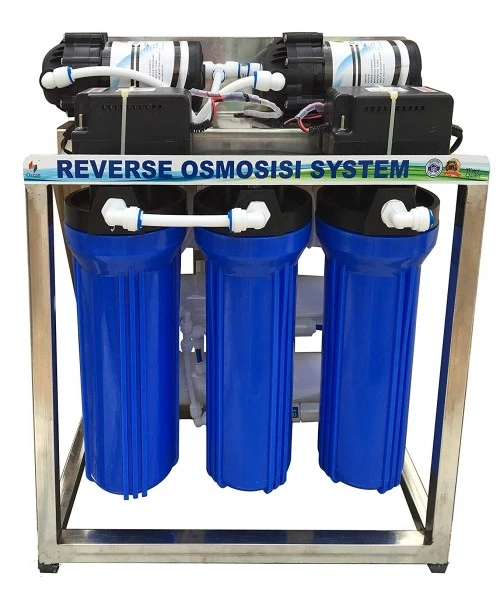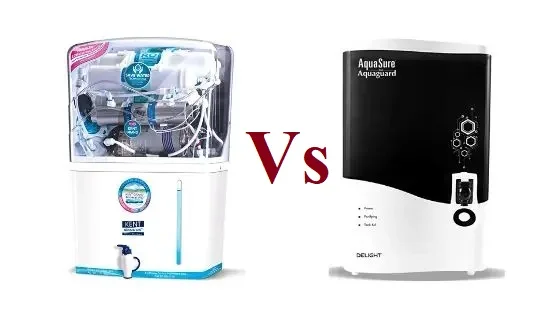Welcome to our comprehensive guide on What are RO and Uf in a water purifier. Reverse Osmosis Water, Difference Between ro and Aquaguard.
What are RO and Uf in a water purifier? Understanding Reverse Osmosis (RO) in Water Purifiers

In today’s fast-paced world, access to clean and safe drinking water is paramount for maintaining good health. Water purifiers have become an indispensable appliance in households, ensuring that the water we consume is free from contaminants.
One of the most advanced and effective technologies employed by modern water purifiers is Reverse Osmosis (RO). In this comprehensive guide, we will delve into the intricate details of RO in water purifiers, shedding light on its functioning, benefits, and why it has become a cornerstone of water purification systems.
What is Reverse Osmosis (RO)?
Reverse Osmosis, often abbreviated as RO, is a cutting-edge water purification technology that is highly efficient in removing impurities, particles, and contaminants from water. It operates on the principle of selectively allowing water molecules to pass through a semi-permeable membrane while blocking out larger molecules and pollutants.
This process involves applying pressure to the water, forcing it to move from an area of higher solute concentration to an area of lower concentration. As a result, the water that emerges on the other side of the membrane is purified and suitable for consumption.
Get The Best RO Water Purifier with UV, UF, and TDS Controller – Click Here
The Intricate RO Purification Process
The RO purification process is a meticulous sequence of stages, each playing a crucial role in ensuring the purity of the water. Let’s explore the step-by-step journey of water through an RO water purifier:
1. Pre-Filtration
Before the water undergoes the RO process, it first passes through a series of pre-filters. These pre-filters are designed to remove larger particles such as sediment, silt, and debris. By eliminating these larger contaminants, the RO membrane’s lifespan is extended, and its efficiency is optimized. “What are RO and Uf in a water purifier, Reverse Osmosis Water, Difference Between ro and Aquaguard”
2. The RO Membrane
At the heart of the RO system lies the semi-permeable membrane. This membrane features microscopic pores that allow water molecules to pass through while blocking out dissolved solids, minerals, bacteria, and viruses. The result is water that is exceptionally pure and devoid of harmful substances.
3. Pressure Application
Pressure is applied to the water to facilitate the osmotic process. This pressure ensures that the impurities are effectively separated from the water molecules, allowing only clean water to pass through the membrane.
4. Disposal of Impurities
The impurities and contaminants that are rejected by the RO membrane are channeled into a separate outlet, preventing them from re-entering the purified water stream. This ensures that the water emerging from the RO system is of the highest quality.
Also Read:
- What is the full form of RO UV and UF?, RO-UV-UF Full Form and Difference?
- How To Filter Water at Home? Top 5 Easy and Effective Ways to Purify Water
- Top 15 Best Refrigerators in India 2023 | Best Refrigerators Under 25000
- What are RO and Uf in a water purifier – Reverse Osmosis Water | Difference Between ro and Aquaguard
Benefits of RO Water Purification

Investing in an RO water purifier offers a multitude of benefits that contribute to enhanced health and well-being:
1. Removal of Harmful Contaminants
RO purification is highly effective in eliminating a wide range of contaminants, including heavy metals, chlorine, pesticides, and pathogens. This ensures that the water is safe for consumption and free from potential health hazards.
2. Improved Taste and Odor
The removal of impurities not only enhances the safety of the water but also leads to a noticeable improvement in taste and odor. RO water is often described as fresher and more palatable.
3. Mineral Retention
While RO systems eliminate many minerals, they also come equipped with features to retain essential minerals like calcium and magnesium. This ensures that the purified water remains balanced and nutritious.
4. Eco-Friendly Solution
RO purification reduces the need for single-use plastic water bottles, contributing to a more sustainable environment. It provides a cost-effective and environmentally friendly alternative to bottled water. “What are RO and Uf in a water purifier, Reverse Osmosis Water, Difference Between ro and Aquaguard”
Why Choose RO Over Other Purification Methods?
The market is saturated with various water purification methods, each claiming to offer superior results. However, RO stands out for several compelling reasons:
1. Unmatched Purity
RO technology is renowned for its unparalleled ability to deliver water that is exceptionally pure. Its multi-stage filtration process ensures the removal of even the smallest impurities.
2. Versatility
RO water purifiers can effectively treat various sources of water, including tap water, well water, and brackish water. This versatility makes them suitable for diverse geographical regions.
3. Long-Term Savings
While the initial investment in an RO water purifier may be higher compared to other methods, its long-term benefits far outweigh the costs. Reduced reliance on bottled water and maintenance costs contribute to significant savings over time.
Understanding Ultrafiltration (UF) in Water Purifiers

In the realm of water purification technologies, Ultrafiltration (UF) stands as a significant advancement, offering efficient and reliable means of obtaining clean and safe drinking water. As part of our commitment to providing comprehensive insights into various water purification methods, we delve into the intricacies of UF, exploring how it works, its benefits, and why it has become a popular choice for many households.
Get the Best Aquaguard water purifier – Click Here
Demystifying Ultrafiltration (UF)
Ultrafiltration is a specialized water purification process that focuses on separating impurities and contaminants from water through a semi-permeable membrane. Unlike some other filtration methods, UF is particularly effective in removing particles and pathogens of larger sizes, ensuring that the purified water is free from substances that can compromise its quality.
The UF Purification Process
The UF process involves the use of a membrane with microscopic pores. As water passes through this membrane under controlled pressure, particles larger than the pore size are unable to proceed, effectively getting trapped and separated from the clean water. The result is water that is significantly cleaner and safer for consumption. “What are RO and Uf in a water purifier, Reverse Osmosis Water, Difference Between ro and Aquaguard”
Key Features and Benefits of UF Water Purifiers:
- Effective Particle Removal: UF technology excels at removing larger particles, including sediments, rust, bacteria, and some viruses. This helps in enhancing the overall quality of water and reducing the risk of waterborne diseases.
- Chemical-Free Purification: UF purification is a chemical-free process, which means that no chemicals are added to the water during the purification process. This is particularly appealing to those who prefer a natural and eco-friendly approach to water treatment.
- Maintaining Essential Minerals: While UF is effective at removing larger contaminants, it does not strip water of essential minerals. This ensures that the purified water retains its nutritional value and benefits.
- Simple Maintenance: UF water purifiers are relatively easy to maintain. The maintenance typically involves periodic cleaning or replacement of the membrane, ensuring consistent performance over time.
- Energy Efficiency: UF purification does not require significant energy consumption, making it an energy-efficient option for households and communities.
Applications of UF Technology:
Ultrafiltration technology finds applications beyond household water purification. It is widely used in various industries, including:
- Food and Beverage: UF is employed in the food and beverage industry to concentrate liquids, remove unwanted components, and improve product quality.
- Pharmaceuticals: UF plays a crucial role in separating and purifying biological molecules, contributing to the production of pharmaceuticals.
- Wastewater Treatment: UF is utilized in wastewater treatment processes to remove suspended solids and microorganisms, producing treated water that meets environmental standards.
- Dialysis: UF is integral to hemodialysis, a medical procedure that removes waste products from the blood of individuals with kidney failure.
Choosing UF Water Purifiers:
When considering a UF water purifier for your household, take into account factors such as water source, purification needs, and maintenance requirements. UF technology is well-suited for areas with relatively clear water sources that require particle and microorganism removal. It is an excellent choice for those seeking a balance between effective purification and the retention of essential minerals.
Understanding the Difference Between RO and Aquaguard Water Purifiers

In the realm of water purification, two prominent names often surface: Reverse Osmosis (RO) and Aquaguard. These are both technologies designed to provide clean and safe drinking water, but they operate on different principles and offer distinct features. In this comprehensive comparison, we will delve into the nuances of RO and Aquaguard water purifiers, highlighting their differences, functionalities, and which might be the better choice for your specific needs.
Reverse Osmosis (RO) Water Purifiers
RO water purifiers are renowned for their exceptional purification capabilities. As discussed in our previous article, RO technology employs a semi-permeable membrane to remove impurities, contaminants, and particles from water. This membrane allows only water molecules to pass through, effectively blocking out pollutants such as bacteria, viruses, heavy metals, and dissolved solids.
Key Features of RO Water Purifiers:
- Comprehensive Filtration: RO systems are highly efficient in removing a wide spectrum of impurities, making the purified water exceptionally pure and safe for consumption.
- Mineral Retention: Many modern RO purifiers are equipped with mineral retention technologies, ensuring essential minerals like calcium and magnesium are preserved in the purified water.
- Improved Taste and Odor: The elimination of impurities often leads to a noticeable improvement in the taste and odor of water.
- Versatility: RO purifiers can effectively treat various sources of water, including tap water, brackish water, and well water.
Aquaguard Water Purifiers
Aquaguard is a brand that offers a range of water purification solutions, with various technologies integrated into their products. One of the notable technologies employed by Aquaguard is UV (Ultraviolet) Purification. Unlike RO, which involves a multi-stage filtration process, UV purification focuses on disinfection by using ultraviolet light to neutralize bacteria, viruses, and other microorganisms present in the water.
Key Features of Aquaguard Water Purifiers:
- UV Purification: Aquaguard purifiers with UV technology rely on ultraviolet light to deactivate harmful microorganisms, ensuring the water is free from waterborne diseases.
- Chemical-Free: UV purification does not involve the use of chemicals, making it an environmentally friendly and chemical-free method of water treatment.
- Real-Time Disinfection: Aquaguard purifiers with UV technology provide real-time disinfection, ensuring that water remains safe for consumption as it flows through the system.
- Quick Processing: UV purification is often faster compared to the multi-stage filtration process of RO purifiers, making it a convenient option for households with immediate water purification needs.
Choosing Between RO and Aquaguard: Which is Right for You?

The decision between RO and Aquaguard water purifiers ultimately depends on your specific requirements and preferences:
- Contaminant Removal: If your primary concern is the removal of a wide range of impurities, including dissolved solids and heavy metals, an RO water purifier might be the ideal choice.
- Bacterial Disinfection: If you are more focused on the elimination of bacteria, viruses, and microorganisms from the water, an Aquaguard purifier with UV technology could be more suitable.
- Taste and Odor: Both RO and Aquaguard purifiers can significantly improve the taste and odor of water by removing pollutants. If taste enhancement is a priority, either option could suffice.
- Water Source: Consider the source of your water. If you have access to tap water or well water with a high mineral content, an RO system with mineral retention could provide balanced and purified water. If you have concerns about microbial contamination, Aquaguard’s UV purification might offer peace of mind.
In conclusion, while both RO and Aquaguard water purifiers serve the crucial purpose of providing clean drinking water, they differ in their methods and focus. Assess your water quality, preferences, and specific needs to determine whether the comprehensive filtration of RO or the microbial disinfection of Aquaguard aligns better with your priorities.
In Conclusion
Reverse Osmosis (RO) technology has revolutionized the way we access and consume safe drinking water. Its intricate purification process, coupled with a myriad of benefits, makes it an ideal choice for households and businesses alike. By understanding the science behind RO and its advantages, you are empowered to make an informed decision when selecting a water purification system that prioritizes your health and well-being.
Ultrafiltration (UF) is a sophisticated water purification technology that addresses the need for efficient and reliable removal of larger particles and contaminants from water. Its chemical-free approach, coupled with its ability to retain essential minerals, makes it a popular choice among households and industries alike. By understanding the principles of UF and its benefits, you can make an informed decision when selecting a water purification solution that aligns with your requirements.
FAQs: What are RO and Uf in a water purifier, Difference Between ro and Aquaguard
Reverse Osmosis (RO) is a water purification process that uses a semi-permeable membrane to remove contaminants, minerals, and impurities from water, producing clean and purified drinking water.
Ultrafiltration (UF) is another water filtration method that utilizes a porous membrane to filter out particles, bacteria, and some larger impurities, ensuring safer drinking water.
RO water undergoes a thorough purification process, removing a higher percentage of impurities compared to tap water. It’s typically free from minerals, contaminants, and pollutants, resulting in a cleaner taste and healthier hydration.
RO is a water purification technology, while Aquaguard is a brand that offers a range of water purifiers utilizing different filtration methods, including RO. Aquaguard products might use RO, UF, UV, or a combination of these technologies, depending on the model.
Drinking RO water can be beneficial, as it eliminates many impurities and contaminants. However, it’s essential to note that some minerals are also removed during the RO process. It’s a good practice to ensure you’re getting a balanced intake of essential minerals from other dietary sources.
While RO purifiers effectively remove contaminants, they also waste a significant amount of water during the purification process. Additionally, some minerals are stripped away, so it’s wise to consider remineralization options if you rely solely on RO water.
UF purification is effective in removing bacteria, viruses, and larger particles, making it suitable for treating well water or borehole water. However, the suitability depends on the specific contaminants present in the water source.
The choice between RO, UF, or other purification methods depends on your water quality, specific needs, and preferences. Consider getting your water tested to determine the most suitable purification technology for your household.
Filter replacement frequency varies based on usage and water quality. As a general guideline, RO filters may need replacement every 6-12 months, while UF filters might last around 12-24 months. Refer to your purifier’s manual for precise recommendations.
Yes, some advanced water purifiers combine multiple filtration methods, including RO and UF, to provide comprehensive water purification. These systems ensure the thorough removal of impurities and contaminants, offering you peace of mind about your water quality.
Thank you for visit to TrustWelly.com

